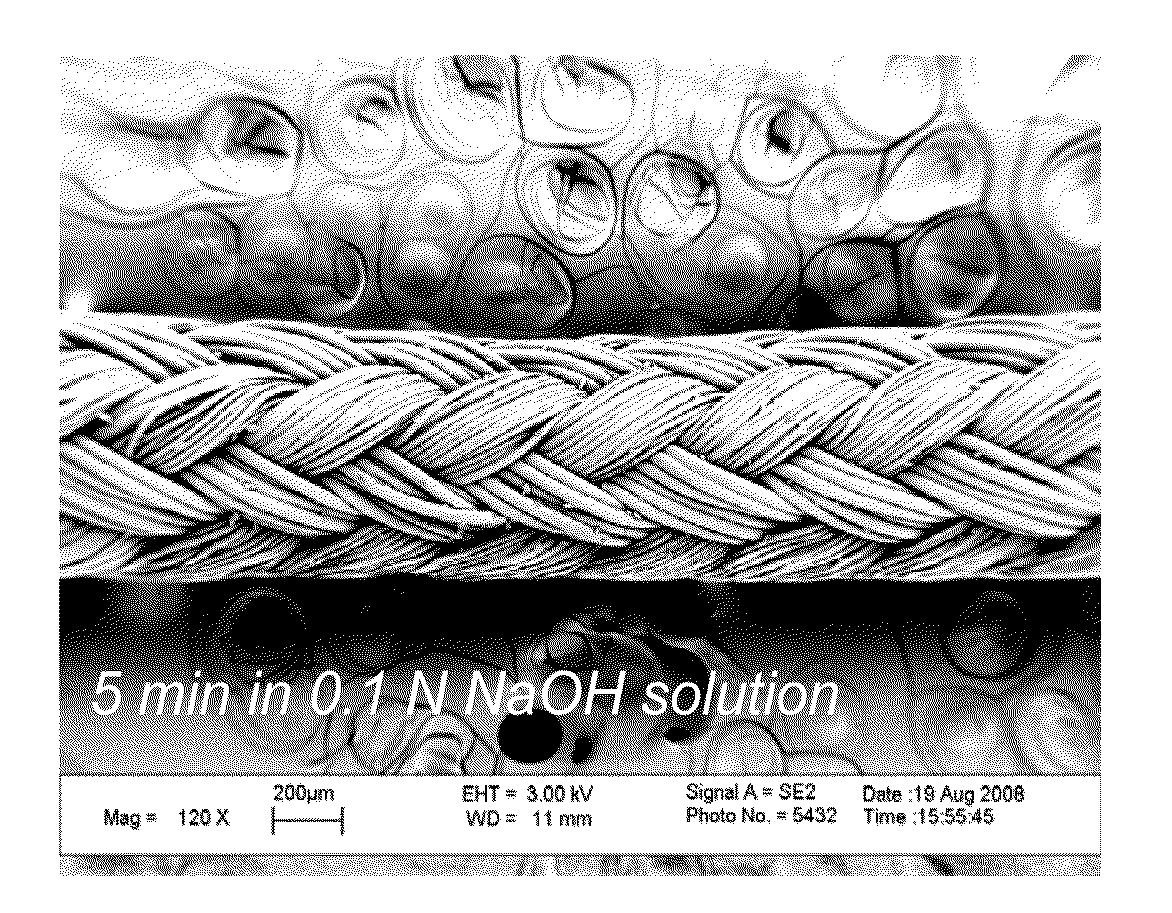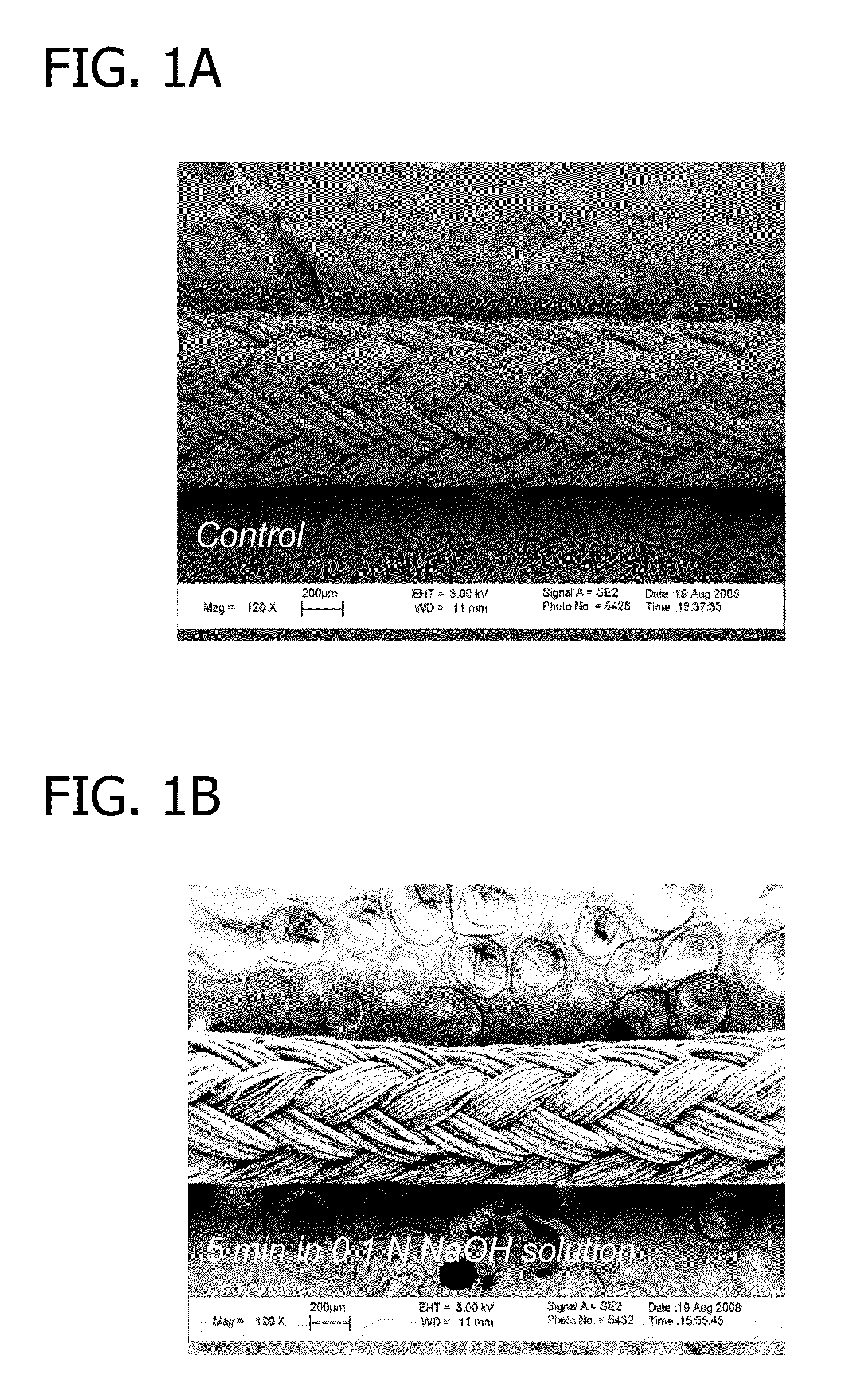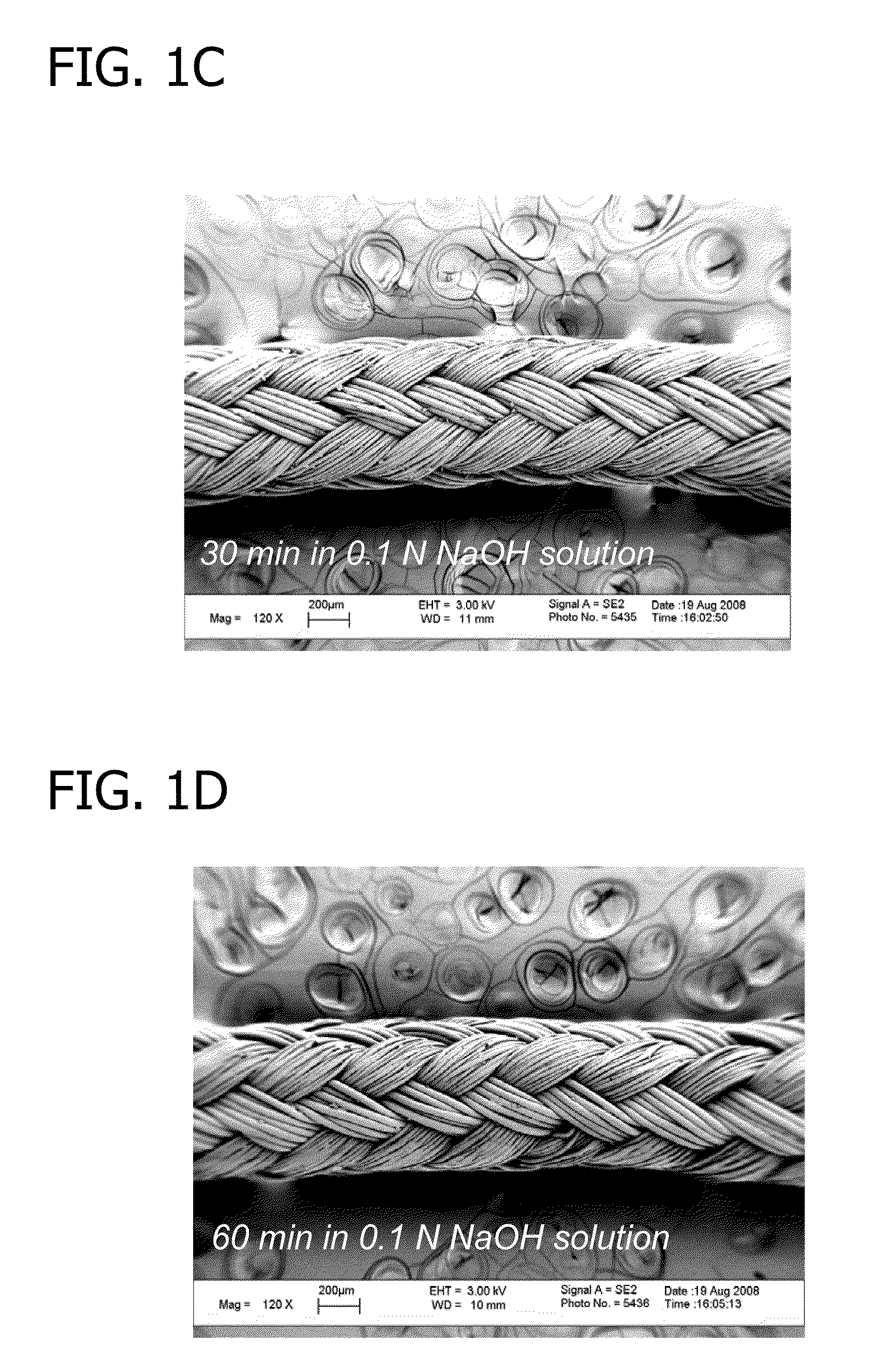Biologically active sutures for regenerative medicine
- Summary
- Abstract
- Description
- Claims
- Application Information
AI Technical Summary
Benefits of technology
Problems solved by technology
Method used
Image
Examples
example 1
[0092]In this example, a hydroxyapatite mineral layer was applied to the surface of sutures.
[0093]To begin, ORTHOCORD™ (USP No. 2; DePuy Mitek, Raynham, Mass.) sutures were treated with 0.1 N NaOH solution for 5 minutes, 30 minutes, or 1 hour. The resulting sutures were hydrolyzed and contained carboxylic acid groups on the suture surface. FIG. 1 depicts a 120× magnification (using LEO 1530 FE-SEM, Zeiss, Germany) of an untreated ORTHOCORD™ suture (FIG. 1A), an ORTHOCORD™ suture treated with 0.1 N NaOH solution for 5 minutes (FIG. 1B), an ORTHOCORD™ suture treated with 0.1 N NaOH solution for 30 minutes (FIG. 1C), and an ORTHOCORD™ suture treated with 0.1 N NaOH solution for 60 minutes (FIG. 1D). As can be seen from FIGS. 1A-1D, the hydrolysis procedure caused no appreciable morphological or mass change in the suture.
[0094]The hydrolyzed, carboxylic acid-rich sutures were then incubated in modified simulated body fluid (mSBF; 141 mM NaCl, 4 mM KCl, 0.5 mM MgSO4, 1.0 mM MgCL2, 4.2 mM...
example 2
[0096]In this example, the hydroxyapatite mineral layer applied to the sutures in Example 1 was evaluated.
[0097]The morphology and composition of the mineralized surface of sutures, prepared as described in Example 1 (60 minute hydrolysis), were characterized using LEO 1530 field-emission scanning electron microscopy (FE-SEM; Zeiss, Germany) equipped with energy dispersive spectroscopy (EDS), respectively.
[0098]Scanning electron microscopy results are shown in FIGS. 3A-3C. FIG. 3A shows a SEM micrograph of uncoated ORTHOCORD™ suture (scale bar: 500 μm), and FIGS. 3B and 3C show SEM micrographs of a mineralized ORTHOCORD™ suture, prepared using the 7-day mineralization procedure described in Example 1 (FIG. 3B scale bar: 500 μm; FIG. 3C scale bar: 5 μm). As can be seen from FIGS. 3B and 3C, the mineral phase uniformly covers the entire surface of the suture (FIG. 3B) and has plate-like microstructure with nanoscale porosity (FIG. 3C) similar to human bone material.
[0099]Energy disper...
example 3
[0104]In this example, the ability of a hydroxyapatite-coated suture to incorporate protein was evaluated.
[0105]To begin, a mineralized ORTHOCORD™ suture, prepared as described in Example 1 (−7 mm, 60 minute hydrolysis), was incubated for 4 hours at 37° C. in a 150 μL solution of either lysozyme (14,300 Da, isoelectric point (pI) 10.7, hydrodynamic radius (RH) 1.9 nm, charge 8.5) or cytochrome c (11700 Da, pI 10.2, RH 1.8 nm, charge 9.5) in PBS (pH 7.4) to allow for incorporation of the protein molecules into the mineralized layer. The concentration of lysozyme or cytochrome c in the protein solutions varied from 100-1000 μg / mL. Specifically, protein concentrations of 100 μg / mL, 200 μg / mL, 400 μg / mL, 600 μg / mL, 800 μg / mL, and 1000 μg / mL were used.
[0106]Fourier transform infrared (FT-IR) spectrometry (Equinox 55 spectrometer, Bruker AXS, Germany) was carried out on the mineralized suture incubated in the lysozyme solution. The results are shown in FIG. 4A. Specifically, FIG. 4A plots...
PUM
| Property | Measurement | Unit |
|---|---|---|
| Ratio | aaaaa | aaaaa |
| Biological properties | aaaaa | aaaaa |
| Biodegradability | aaaaa | aaaaa |
Abstract
Description
Claims
Application Information
 Login to View More
Login to View More - R&D
- Intellectual Property
- Life Sciences
- Materials
- Tech Scout
- Unparalleled Data Quality
- Higher Quality Content
- 60% Fewer Hallucinations
Browse by: Latest US Patents, China's latest patents, Technical Efficacy Thesaurus, Application Domain, Technology Topic, Popular Technical Reports.
© 2025 PatSnap. All rights reserved.Legal|Privacy policy|Modern Slavery Act Transparency Statement|Sitemap|About US| Contact US: help@patsnap.com



